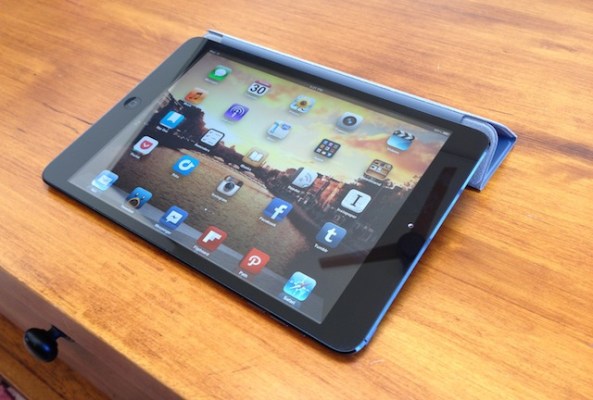Apple is expected to refresh its iPad line-up next month, likely adding a Retina display to the iPad mini, and perhaps pushing the iPhone 5s’ Touch ID fingerprint sensor-fuelled home button into a new flagship iPad. But even as Cupertino upgrades the iPad’s capabilities, its dominance in the tablet category is coming to an end — as the sheer size of the Android ecosystem inexorably dents the iPad’s universe.
Analyst ABI Research has flagged up what it describes as a “shift in leadership” in the tablet space, with Apple’s iPad family passing the baton to Android in three areas. Firstly in shipments: ABI notes that Android-powered tablets surpassed iOS-based slates during Q2 for the first time. Secondly, it says tablet-related hardware revenues in Android and iOS reached parity at the mid-point of the year; and third it notes that the average selling price (ASP) of the iPad is “rapidly approaching the market average.”
Apple reported its first yearly decline in iPad sales in its Q3 results back in July, with 14.6 million iPads sold in the quarter (vs 17 million in the year-ago quarter). Apple of course competes with multiple Android OEMs — which in the tablet space includes Amazon with its Kindle Fire range; Samsung with its Galaxy Note line up; and Google’s Nexus slates. So it’s fair to say that Android-powered tablets passing iPad shipments at some point was all but inevitable, with multiple companies attacking the iPad maker.
Amazon and Google especially have used price as the differentiator to move more tablet-shaped boxes by undercutting the iPad’s premium pricing. That it’s taken the Android ecosystem more than three years to be shipping more slates than Apple is a measure of how relatively poor Android tablets have been vs the iPad experience (it’s no coincidence that Google felt it needed to get involved directly with the tablet space with its own-branded Nexus slate to help bring up standards and push down prices).
Overall, ABI says tablet shipments grew more than a fifth (23 percent) year-over-year in Q2, while the market declined 17 percent sequentially.
On the revenues front, overall, ABI estimates that tablet shipments in Q2 generated revenues of $12.7 billion — with the iPad accounting for (only) 50 percent of worldwide end-user revenues. That’s notable because it’s the first time Apple’s slate has not dominated market revenues. Albeit, it still means Apple split the market in the quarter — taking the largest share for itself, while all other branded vendors shared $6.3 billion among themselves.
A shift to smaller slates
A dip in iPad sales and the lower-cost iPad mini go some way to explaining reduced revenues for Apple in the tablet space. But with multiple Android OEMs targeting the 7-inch small slate space before Apple did, there was a clear need for Cupertino to introduce a smaller iPad, whatever the costs on the revenue cannibalisation front. (Cannibalising itself is not, in any case, something Apple shies away from.)
ABI’s data reinforces the importance of the small slate category, noting that circa 7-inch tablets finally became the category majority in Q2. Apple’s own small slate also dominated overall iPad shipments — and accounted for nearly half of iPad revenues. “The 7.9-inch iPad mini represented about 60% of total iPad shipments and 49% of iPad-related device revenues in the quarter,” notes ABI senior practice director Jeff Orr in a statement.
The iPad mini, which launched just under a year ago and costs $329 vs $499 for the Retina iPad (or $399 for the iPad 2), is the main cause of a 17 percent drop in the ASP of the iPad over the past year. “The iPad drop is primarily attributed to the introduction and volume shift to the smaller iPad mini,” ABI notes.
Yet, while the ASP of the iPad has been falling — as buyers shift their cash to Apple’s smaller, lower cost slate — the ASP of the rest of tablet market has increased 17 percent over the same period. ABI attributes that to competition heating up and iPad rivals being able to match and even best the capabilities of Apple’s hardware. “Twelve months is a long time for the peak lifecycle of a contemporary tablet. To remain a leader, Apple must continue to innovate and address real-world market needs,” adds Orr.
